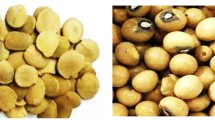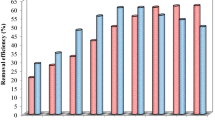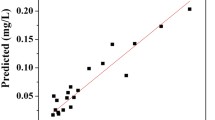Abstract
Coagulation is a well-established approach in textile wastewater treatment because of its capacity to destabilise colloidal particles, facilitate their settling, and promote efficient colour removal. Nevertheless, process optimisation is necessary to strike a balance between achieving optimal treatment efficiency and minimizing the environmental impact of excessive chemical addition. Present study aims to optimises the colour removal using response surface methodology and compare the performance of polyaluminum chloride (PAC) and ferric chloride. Additionally, the paper discusses the impact of the interaction effects of independent variables as well as the chemistry underlying the interactions. Synthetic wastewater containing Navy Blue RX dye was used in this study. Initial dye concentration, initial pH and coagulant dose were used as independent variables while decolourization/colour removal was selected as response variable for optimisation. The optimisation results showed 63.56% colour removal at 100 mg/L initial dye concentration, 9 pH, and 2.23 mM FeCl3 dosage while 91.9% colour removal was accomplished using 340 mg/L PAC dosage with initial dye concentration of 100 mg/L and pH 7. The PAC demonstrated a greater degree of decolourization than FeCl3. This strategy ensures that the process is optimized for optimum efficiency while also saving time and resources. Response surface methodology proved to be a potent instrument in optimizing the coagulation process to remove dye from wastewater.
Graphical abstract





Similar content being viewed by others
Data availability
The data that support the findings of this study are available from the corresponding author, [Abhipsa R Makwana, abhipsamakwana78@gmail.com], upon reasonable request.
References
Al-Tohamy R, Ali SS, Li F et al (2022) A critical review on the treatment of dye-containing wastewater: ecotoxicological and health concerns of textile dyes and possible remediation approaches for environmental safety. Ecotoxicol Environ Saf 231:113–160. https://doi.org/10.1016/j.ecoenv.2021.113160
APHA, AWWA, WEF (1998) Standard methods for the examination of water and wastewater
Banat IM, Nigam P, Singh D, Marchant R (1996) Microbial decolorization of textile-dyecontaining effluents: a review. Bioresour Technol 58(3):217–227. https://doi.org/10.1016/S0960-8524(96)00113-7
Bezerra MA, Santelli RE, Oliveira EP et al (2008) Response surface methodology (RSM) as a tool for optimization in analytical chemistry. Talanta 76:965–977
Duan J, Gregory J (2003) Coagulation by hydrolysing metal salts. Adv Colloid Interface Sci 100:475–502. https://doi.org/10.1016/S0001-8686(02)00067-2
El-Gohary F, Tawfik A (2009) Decolorization and COD reduction of disperse and reactive dyes wastewater using chemical-coagulation followed by sequential batch reactor (SBR) process. Desalination 249(3):1159–1164. https://doi.org/10.1016/j.desal.2009.05.010
Eslami H, Zarei Mahmoudabadi T (2022) Modified coagulation processes using polyferric chloride and polytitanium tetrachloride for the removal of anionic dye from aqueous solution. Int J Environ Sci Technol 19:1811–1818. https://doi.org/10.1007/s13762-021-03293-3
Extross A, Waknis A, Tagad C et al (2023) Adsorption of congo red using carbon from leaves and stem of water hyacinth: equilibrium, kinetics, thermodynamic studies. Int J Environ Sci Technol 20:1607–1644. https://doi.org/10.1007/s13762-022-03938-x
Gao B-Y, Yue Q-Y, Wang Y, Zhou W-Z (2007) Color removal from dye-containing wastewater by magnesium chloride. J Environ Manag 82(2):167–172. https://doi.org/10.1016/j.jenvman.2005.12.019
Golob V, Vinder A, Simonič M (2005) Efficiency of the coagulation/flocculation method for the treatment of dyebath effluents. Dye Pigment 67(2):93–97. https://doi.org/10.1016/j.dyepig.2004.11.003
Jiang J-Q (2001) Development of coagulation theory and pre-polymerized coagulants for water treatment. Sep Purif Rev 30(127):141. https://doi.org/10.1081/SPM-100102986
Khan MD, Singh A, Khan MZ et al (2023) Current perspectives, recent advancements, and efficiencies of various dye-containing wastewater treatment technologies. J Water Process Eng 53:103579. https://doi.org/10.1016/j.jwpe.2023.103579
Kim T-H, Park C, Shin E-B, Kim S (2004) Decolorization of disperse and reactive dye solutions using ferric chloride. Desalination 161(1):49–58. https://doi.org/10.1016/S0011-9164(04)90039-2
Kumar P, Prasad B, Mishra IM, Chand S (2008) Decolorization and COD reduction of dyeing wastewater from a cotton textile mill using thermolysis and coagulation. J Hazard Mater 153(2):635–645. https://doi.org/10.1016/j.jhazmat.2007.09.007
Mahmoudabadi TZ, Talebi P, Jalili M (2019) Removing disperse red 60 and reactive blue 19 dyes removal by using Alcea rosea root mucilage as a natural coagulant. AMB Express 9:113. https://doi.org/10.1186/s13568-019-0839-9
Montgomery DC (2010) Design and analysis of experiments, 7th edn. Wiley, New Delhi
Myers RH, Montgomery DC, Anderson-Cook CM (2009) Response surface methodology: process and product optimization using designed experiments, 2nd edn. Wiley, New York
Nair AT, Makwana AR, Ahammed MM (2014) The use of response surface methodology for modelling and analysis of water and wastewater treatment processes: a review. Water Sci Technol 69:464–478. https://doi.org/10.2166/wst.2013.733
Nateghi R, Bonyadinejad G, Amin M, Assadi A (2013) Application of coagulation process reactive blue 19 dye removal from textile industry wastewater. Int J Environ Health Eng 2:5. https://doi.org/10.4103/2277-9183.107913
Sadeghpour P, Haghighi M, Haghighi A, Shabani M (2022) Ultrasonic-promoted growth of staggered heterostructured tin(II) oxide nanoparticles on bulk carbon nitride nanolayer: activated in solar spectrum with enhanced photocatalytic treatment of dyes effluents. Sol Energy 241:437–451. https://doi.org/10.1016/j.solener.2022.06.027
Sadri Moghaddam S, Alavi Moghaddam MR, Arami M (2011) Response surface optimization of acid red 119 dye from simulated wastewater using Al based waterworks sludge and polyaluminium chloride as coagulant. J Environ Manag 92:1284–1291. https://doi.org/10.1016/j.jenvman.2010.12.015
Sharifi N, Mohadesi M (2024) Textile wastewater treatment using solar photo-fenton process. Int J Environ Sci Technol. https://doi.org/10.1007/s13762-023-05397-4
Shi B, Li G, Wang D et al (2007) Removal of direct dyes by coagulation: the performance of preformed polymeric aluminum species. J Hazard Mater 143(2):567–574. https://doi.org/10.1016/j.jhazmat.2006.09.076
Shojaei S, Shojaei S (2019) Optimization of process variables by the application of response surface methodology for dye removal using nanoscale zero-valent iron. Int J Environ Sci Technol 16:4601–4610. https://doi.org/10.1007/s13762-018-1866-9
Tariq A, Islam S, Shaikh IA et al (2022) Performance assessment of alum as coagulant for degradation of disperse dyes from aqueous medium. Int J Environ Anal Chem 102:5951–5960. https://doi.org/10.1080/03067319.2020.1806254
Uduma RC, Oguzie KL, Chijioke CF et al (2023) Bioelectrochemical technologies for simultaneous treatment of dye wastewater and electricity generation: a review. Int J Environ Sci Technol 20:10415–10434. https://doi.org/10.1007/s13762-022-04753-0
Uppala R, Sundar K, Muthukumaran A (2019) Response surface methodology mediated optimization of decolorization of azo dye amido black 10B by Kocuria kristinae RC3. Int J Environ Sci Technol 16:4203–4214. https://doi.org/10.1007/s13762-018-1888-3
Vairavel P, Rampal N, Jeppu G (2021) Adsorption of toxic Congo red dye from aqueous solution using untreated coffee husks: kinetics, equilibrium, thermodynamics and desorption study. Int J Environ Anal Chem 103:2789–2808. https://doi.org/10.1080/03067319.2021.1897982
Verma AK, Dash RR, Bhunia P (2012) A review on chemical coagulation/flocculation technologies for removal of colour from textile wastewaters. J Environ Manag 93(1):154–168. https://doi.org/10.1016/j.jenvman.2011.09.012
Ye C, Wang D, Shi B et al (2007) Alkalinity effect of coagulation with polyaluminum chlorides: role of electrostatic patch. Colloids Surf A Physicochem Eng Asp 294(3):163–173. https://doi.org/10.1016/j.colsurfa.2006.08.005
Zahrim AY, Hilal N (2013) Treatment of highly concentrated dye solution by coagulation/flocculation-sand filtration and nanofiltration. Water Resour Ind 3:23–34. https://doi.org/10.1016/j.wri.2013.06.001
Zarei Mahmoudabadi T, Abbasi F, Jalili M, Talebi P (2019) Effectiveness of plantago major extract as a natural coagulant in removal of Reactive Blue 19 dye from wastewater. Int J Environ Sci Technol 16((12)):7893–7900. https://doi.org/10.1007/s13762-018-02201-6
Zhai J, Huang Z, Rahaman MH et al (2017) Comparison of coagulation pretreatment of produced water from natural gas well by polyaluminium chloride and polyferric sulphate coagulants. Environ Technol 38((10)):1200–1210. https://doi.org/10.1080/09593330.2016.1217937
Zhang S, Zhong L, Wang J et al (2021) Porous carbon-based MgAlF5·1.5 H2O composites derived from carbon-coated clay presenting super high adsorption capacity for Congo Red. Chem Eng J 406:126784. https://doi.org/10.1016/j.cej.2020.126784
Zonoozi MH, Moghaddam MRA, Arami M (2009) Coagulation/flocculation of dye-containing solutions using polyaluminium chloride and alum. Water Sci Technol 59:1343–1351. https://doi.org/10.2166/wst.2009.128
Acknowledgements
The authors are grateful to DST-FIST for providing facilities at Environmental Engineering Lab for conducting experimental work.
Author information
Authors and Affiliations
Contributions
Sonali Patel: Investigation, Writing–original draft. Abhilash T. Nair: Methodology, Software, Validation, Data curation, Writing–original draft, Writing–review & editing. Abhipsa R. Makwana: Conceptualization, Methodology, Software, Data curation, Validation, Supervision, Writing–review & editing.
Corresponding author
Ethics declarations
Conflict of interest
The authors declare that they have no known competing financial interests or personal relationships that could have appeared to influence the work reported in this paper.
Ethical approval
This article does not contain any studies with human participants or animals performed by any of the authors.
Additional information
Editorial responsibility: S. Mirkia.
Supplementary Information
Below is the link to the electronic supplementary material.
Rights and permissions
Springer Nature or its licensor (e.g. a society or other partner) holds exclusive rights to this article under a publishing agreement with the author(s) or other rightsholder(s); author self-archiving of the accepted manuscript version of this article is solely governed by the terms of such publishing agreement and applicable law.
About this article
Cite this article
Patel, S., Nair, A.T. & Makwana, A.R. Optimizing coagulation of Navy Blue RX dye and comparative study of performance of polyaluminium chloride and ferric chloride. Int. J. Environ. Sci. Technol. (2024). https://doi.org/10.1007/s13762-024-05662-0
Received:
Revised:
Accepted:
Published:
DOI: https://doi.org/10.1007/s13762-024-05662-0




